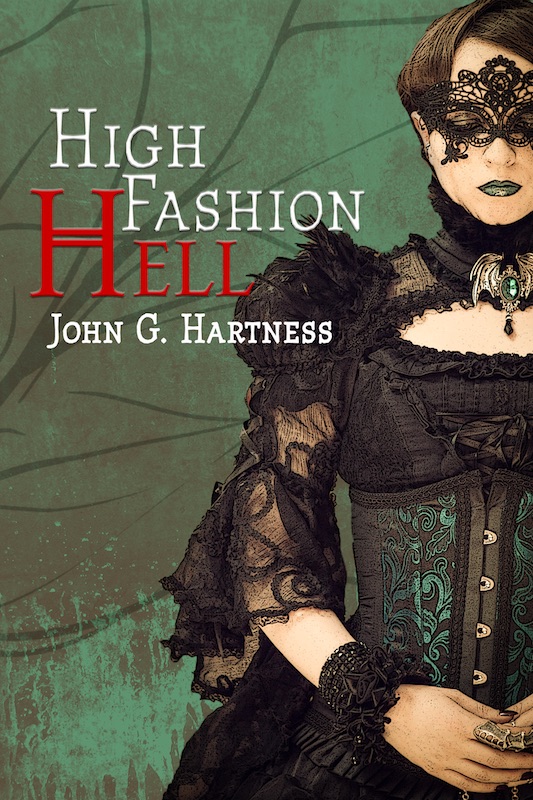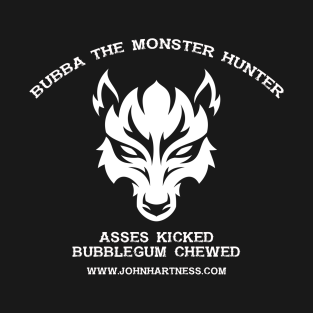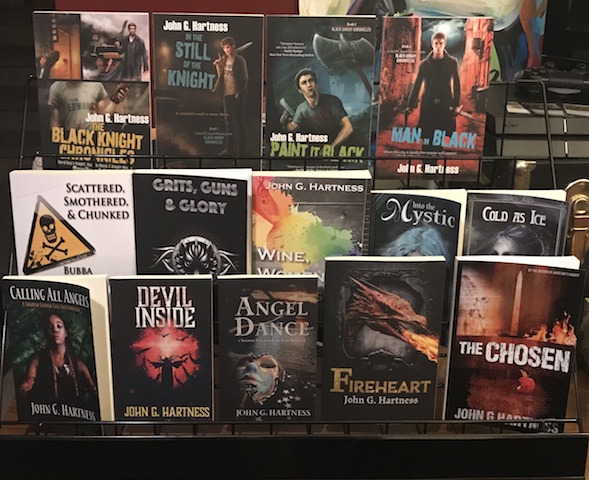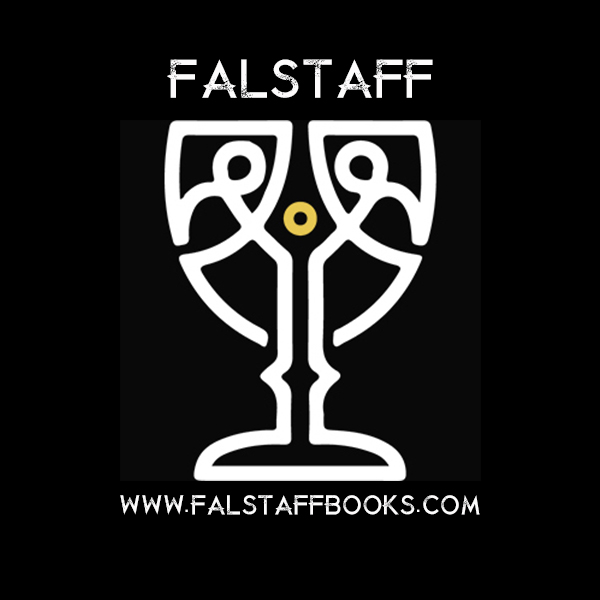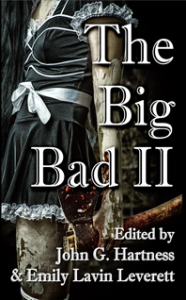
by john | Feb 20, 2015 | Book Spotlight, Evolution of Evil, Writing
James R. Tuck is my brother from another mother, one of my favorite people, one of my favorite writers, and one of the best friends I’ve got in this business. I love everything he writes, from Deacon Chalk to the Big Bad, and it’s always an honor to have him share his words with me in these anthologies. Here’s his story about his story.
It’s Neil Gaiman’s fault.
Kind of.
Well, he’s good enough to blame anyways.
My story in the last one had a supervillian, and he was evil, but for Big Bad 2 I wanted to go really evil. Old school evil. Hardcore evil.
I put on my thinking cap and came up with the concept of the Devil in a concentration camp.
Can’t really get more evil than that now can you?
I needed a reason for him to be there and so I ripped off Gaimen. In my story, we have a Devil who, as part of his curse, is forced to live a human life every year. (If perchance you do not know how this is ripping off Neil Gaimen then stop and immediately order DEATH: THE TIME OF YOUR LIFE by him. Hell, just go ahead and pick up the Sandman Omnibus vol 1 & 2. You’ll thank me for it.) This fits with the narrative of the Bible as we have a few occurances of Old Slewfoot showing up and actually being a real presence.
The Devil HATES these days and he doesn’t ever want to do them. He’s been able to push off these mandatory human life days longer and longer as his power grows. This is the reason he believes he will one day be able to win his struggle against God.
However, the day has come upon him in the middle of World War 2, and he decides to take over the life of a concentration camp guard.
My plan when picking this was to go full-bore evil. I had the Devil’s number, got him in one fell swoop as a right bastard, just the kind of prick you’d think the Prince Of Darkness would be.
Oh, this story was going to be some truly twisted, therapy-inducing horror.
Then Hadassah showed up.
Simple Hadassah. Straightforward Hadassah. Courageous Hadassah.
She ruined my plans and made this story about something else, something more. There is evil here, it’s on the page and in the subtext, but with Hadassah the story became about humanity. The ability we have to hold to our own faith and dignity even in the very mouth of the devourer. I’ve written many tales in my time. Some of them have been damn good.
This story is one of them I am most proud of.
It’s outside my wheelhouse, far outside my voice, and it’s about something.
No, it’s about somethings. There’s a texture to it that I’m pleased with. Normally I write very surface, guns and monsters and things that go boom, but not in this time.
This is a quiet story.
Enjoy.


by john | Feb 18, 2015 | Evolution of Evil, Guest Blogs, Writing
Monsters, Trailer Parks and Truck Stops
By Gail Z. Martin
People who aren’t from Pennsylvania picture two cities: Pittsburgh and Philadelphia. If you’re from PA, you know that the state’s whole center is farmland and nearly uninhabited forest (drive across I-80 sometime and you’ll see what I mean). Where I grew up, in the top corner near Lake Erie, not only do most people have a taxidermist on speed dial, but I’m pretty sure the car dealerships not only sell pickup trucks with gun racks as standard equipment, but I think the guns may be part of the package. Schools and businesses officially close for the first day of Deer Season. Most people I knew could field dress a deer with a pocket knife.
This matters because there’s urban horror and then there’s rural horror. They play off different kinds of fears. Urban horror plays off the anonymity of the big city, the strangers, the manmade caverns of concrete and the trackless tunnels underneath, dark alleys and seedy neighborhoods. Rural horror is a little more primal: wild animals, crazy loners holed up in caves or cabins, the brutal Darwinism of the elements and the fear of what you find in the vast, empty darkness, far away from street lights or cell phone signals.
My story for Big Bad 2 was inspired by getting lost in rural areas, and unexpected inspiration at a truck stop.
We’ve still got family in Northwestern PA, even though we’ve been in North Carolina for nearly 20 years. So we have worn a groove in I-77 and I-79 North over the years, heading nearly all the way up to the shores of Lake Erie. We’ve got the drive down to a science, and we trade off drivers every two hours at our favorite places to stop. One of those is a Flying J truck stop in Fort Chiswell, VA. It’s one of those restaurant/gas station/convenience store/gift shop kind of places, and one day, as I was getting a huge cup of coffee for the road, one of their t-shirts caught my eye.
“Mess with me, and you mess with the whole trailer park.” The guy depicted on the graphic looked like someone out of Cabin in the Woods, not the shell with the most gunpowder, if you know what I mean. But for some reason, that statement of backwoods solidarity got me thinking. What if the trailer park was full of monsters? Hmm.
Getting lost in a city can be scary if you end up a bad neighborhood. Getting lost in rural areas means you’re not in anybody’s neighborhood. Three 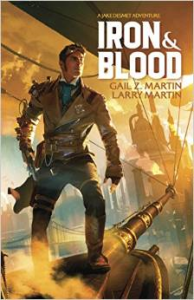 situations made an impression on me. In one case, it was late at night, we were back home in what should have been our stomping grounds, and we missed a turn on a rural road. No problem, we had a pretty good idea of where we were, and we took the next left, expecting it to cut across. The blacktop road went from two lanes to one lane, then became a gravel road, then a dirt road. This was before GPS. I thought our odds were good of ending up in front of someone’s barn, facing a big German Shepherd and the business end of someone’s shotgun.
situations made an impression on me. In one case, it was late at night, we were back home in what should have been our stomping grounds, and we missed a turn on a rural road. No problem, we had a pretty good idea of where we were, and we took the next left, expecting it to cut across. The blacktop road went from two lanes to one lane, then became a gravel road, then a dirt road. This was before GPS. I thought our odds were good of ending up in front of someone’s barn, facing a big German Shepherd and the business end of someone’s shotgun.
Now we probably would have been OK. We were on home territory, and that meant we could have played the “Do you know my parents, aunts, cousins, cousin’s sister-in-law’s aunt’s neighbor” verification-by-relative game. But it’s a scary thing bouncing down a road without street lights that isn’t on the map and where there are no signs to tell you which road you’re on if the mile markers aren’t enough for you to know. There’s a whole lot of dark emptiness out there.
Another time, we had to get off I-79 onto a detour in West Virginia because of road construction and we somehow lost the detour. This is a bad thing if you’re not from there, and we aren’t. See, there are what’s called “hollers”, or mountain valleys. There’s the front of the holler and the back of the holler. First rule: you don’t go into the holler if you don’t belong there. Second rule: you don’t come out of the back of the holler if you go in there and you don’t belong there. It was a ‘paddle faster, I hear banjos’ kind of moment.
Then there was the time I was taking my daughter back to Penn State, which is in the middle of the state and the middle of nowhere. We missed a turn (ok, maybe I shouldn’t navigate), and said ‘that’s OK, we’ve got GPS’. Yeah well. Instead of four-lane highway, we took a charming scenic detour through increasingly smaller hamlets on one-lane roads that were wavier than pan-fried bacon. I was fine with it—it was daylight, we had a full tank of gas, and it wasn’t like we were going to run into cow gangs from the wrong side of the tracks. There were even places where the cell phones kinda worked.
But my daughter, raised in Pittsburgh and Charlotte, got more and more nervous the farther we got from ‘civilization’. When I stopped for gas at a no-name station in a tiny one-traffic-light town and had to pay inside (horrors!) she actually locked the car doors until I came back. (Just because everyone in sight is wearing camo does not mean you’re in danger. Up there, they sell camo lingerie and camo baby onesies, just sayin’.) But her nervousness outside her comfort zone got my writer brain working on what makes us afraid.
Put it all together, and you get “Old Nonna,” my story for Big Bad 2.
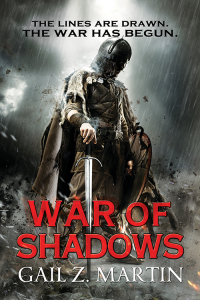
About the Author:
Gail Z. Martin is the author of the new epic fantasy novel War of Shadows (Orbit Books) which is Book Three in the Ascendant Kingdoms Saga; Vendetta: A Deadly Curiosities Novel in her urban fantasy series set in Charleston, SC (Solaris Books); and Iron and Blood: The Jake Desmet Adventures a new Steampunk series (July 2015, Solaris Books) co-authored with Larry N. Martin. She is also author of Ice Forged and Reign of Ash in The Ascendant Kingdoms Saga, The Chronicles of The Necromancer series (The Summoner, The Blood King, Dark Haven, Dark Lady’s Chosen) from Solaris Books and The Fallen Kings Cycle (The Sworn, The Dread) from Orbit Books. Gail writes two series of ebook short stories: The Jonmarc Vahanian Adventures and the Deadly Curiosities Adventures and her work has appeared in 20 US/UK anthologies.
Find her at www.AscendantKingdoms.com, on Twitter @GailZMartin, on Facebook.com/WinterKingdoms, at DisquietingVisions.com blog and GhostInTheMachinePodcast.com, on Goodreads https://www.goodreads.com/GailZMartin and free excerpts on Wattpad http://wattpad.com/GailZMartin.
by john | Feb 16, 2015 | Book Spotlight, Evolution of Evil, Writing
Am I Evil?
By Jay Requard
Believe it or not, I’m pissed off.
I’m pissed off because I failed Conjer, Emma, and whoever that vampire-fop that ended up beheaded at the end of the third act. I failed them all, and every bit of it has to do with the fact that I didn’t know if I could be what I needed to be. I didn’t know if I could be evil. I consider myself a Heroic Fantasy author, so you probably imagine the kind of cognitive dissonance that entailed.
The first story, The Chase, appeared in The Big Bad: An Anthology of Evil, which featured many great stories featuring truly messed-up things being done by really messed-up people. But that didn’t mean we did evil. I am one of those (psychos) that take the time to read the reviews that followed on Amazon, and beyond a lot of really nice reviews and some well-earned praise for some really talented authors, there was one review that struck me in the face with shame.
“They’re really light on evil,” is essentially what was said, when paraphrased to protect who said. I’ll leave it to you to go and guess which review I’m talking about.
“Light on evil.”
That’s not good enough. It’s not good enough for me, specifically, because I know that I failed. I tried to make Conjer a darker, moodier version of The Man with No Name, one of my favorite characters from the Sergio Leoni-classics. Yet that character isn’t inherently a villain, and villains are supposed to be the bread and butter of The Big Bad II.
So here comes The Big Bad II. I submitted Ghosts and Sands to Emily Leverett and John Hartness, having to fight my way again into the second anthology. I wasn’t invited, I wasn’t called to submit another story—I had to work. And I had to figure out “am I evil?”
To me, evil is someone walking into town knowing he is going to kill scores and smiles about it. To me, evil is killing someone who was trying to do a job they didn’t want to be doing in the first place. To me, evil is making victims pay for rescue and salvation. To me, evil is having a good time doing it.
These are things that happen every single day in the real world, performed by those high and low, lawful and criminal. They may seem mundane to readers, in the grand scheme of things, but that’s because the readers are evil too—they accept this deepening shithole around them while they turn to the next page.
Conjer came back, ready to unleash hell. He’s not the hero you need; he’s the curse you have to endure. And curses always find a way to claim you.
I hope I didn’t fail this time. You can be the judge and answer my question: Am I Evil?
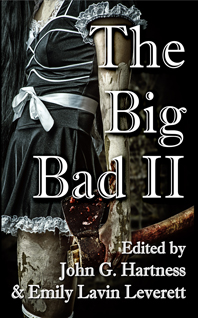
by john | Feb 6, 2015 | Business of publishing, Vampires, Writing
I use Selah Janel’s story in The Big Bad volume 1 as both a cautionary tale on everything NOT to do when submitting to an anthology, as well as a cautionary tale on the benefits of being friends with people in the industry, most notably editors or people who might one day become editors. When Selah and I became friends, I had no intentions of editing anything, much less a series of horror anthologies. But I did, and when it came time to start reading for The Big Bad, I got an email from Selah saying (basically) “I have a story, but I’m running a little late, and a little long. Can I have a couple weeks?” I said “Sure, send it along when it’s ready.” A month later I get another email with a story attached saying (basically) “Here is it, sorry it’s so late, hope you still like me, hope you can use it.”
It was almost exactly 1,000 words OVER the max allowed word count for the anthology. I almost round-filed it immediately, but she was my friend, and that guaranteed her at least one paragraph’s worth of leniency. You can see why I don’t have many friends – it only got her a paragraph. I read it, then waited patiently as Emily (my co-editor and partner in crime on these anthologies) read it. She emailed me and we agreed that the story had done almost every single thing wrong to get included. It was late, it was too long, it was another friggin’ vampire story. We wanted any excuse to hate it.
Sidebar – when you’re accepted into an anthology, after a few acceptances, you stop asking “Really?” and start asking “Where will you put my story?” There are three pieces of prime real estate in an anthology – the first story, which gets read by the most casual readers, the center story, which gets read by a lot of passersby who crack the book open randomly and pick a page, and the final story, which is the closer and wants to be a big finish.
Selah’s story was the closer for Big Bad Vol. 1. It was, quite frankly, one of the best damn vampire stories I’ve ever read. I looked for any excuse not to love it, and she didn’t give me one. I’ve told lots of people at lots of panels at lots of conventions that you can either follow all the rules or be so goddamn amazing that they don’t apply to you. Seals Janel is an amazing writer and I’d read her grocery list. Here’s her story behind the story for Big Bad 2. And no, she didn’t get the closer spot in BB2, we dropped her in the second spot from the beginning, because editors are evil. You see, if you download the free sample from Amazon for the ebook, you’ll get cut off before Selah’s story ends. And that’s going to guarantee a high conversion of samples to sales. 🙂
Plain and simple, I love vampires. There’s a lot of versatility there, a lot of things to explore. One of my favorite vampire movies is The Lost Boys, and admittedly my story in the first Big Bad, “Real Wild Childe” came out of one of the few beefs I have with the original movie: the horrifically lame female characters in cliché roles. While I admire Jami Gertz and Diane Wiest and they’re great in the film, Star and Lucy’s functions are to just kind of be there as love interest and Mom. It’s a shame, because a lot could have been done with those archetypes. The sequels never really bothered to correct the female role issue, either, so it became a mission to write a vampire story where the girls could keep up with the boys and then some. Admittedly, “Real Wild Childe” was also my chance to warp the vampire romance genre beyond recognition, but a lot of it was the chance to have fun with some renegade vampire characters while beefing up the female roles. In a lot of ways, I did a whole reversal with putting Rave at the mercy of all the women in his life, vampire and human.
When the second volume was announced, I was sure I was going to sequel that story. I was excited to keep exploring Rave and Sin’s twisted relationship, as well as Addington’s vampire problem as a whole. Unfortunately, it became evident very quickly that it would be way too much for an anthology story, and I already had the habit of antagonizing the great Hartness with my inflated word counts. I didn’t want to leave that world behind, though, so it occurred to me to go in the other direction and prequel it.
I mention in the original story that Rave and Asha’s sire is their mother, and she’s not a particularly motherly type. Amanda was the perfect character to explore not only the feminine role of mother, but also to mash that up against what a vampire was, and why a typical 1950’s housewife would even want to become one. My research led me on a winding road, and I found the perfect excuse for an underground, mother-centric vampire cult: fear of communism and all-out nuclear war. What if a protective instinct was so great, that you’d do anything to ensure your family line and the wellbeing of your kids, even if it meant killing and drinking blood?
That was a great start at developing the cult of The Family and the character of The Patriarch, but it still didn’t quite mesh up with the Amanda in the original story. What kind of a person would turn into a manipulative, jealous vampire who wanted to clamp down on her kids and rule over them throughout eternity? After all, most parents are more than willing to kick the birds out of the nest at some point, and Amanda had never come across as a loving maternal figure.
As I began writing, I slowly discovered a character who was burnt out, frustrated, and felt overlooked. Her insecurities about her own life fed her jealousy that landed on everyone: her husband’s employees, her friends and fellow cult members, even her own children. She was desperate to be noticed, true, but also desperate for something else. It all made me wonder, what would happen if a mother didn’t necessarily have children because of a great love for them, but because they complemented her idea of what life should be like? What if she looked upon them as accessories that she owned, accessories that weren’t supposed to ever get out of line or go against her thinking? What if that craving for power gave her confidence to try out her powers in increasingly controlling ways, all under the guise of it being in everyone’s best interest? And what would she do if her precious family/accessories dared to try to go against her?
And what would happen if she found out that they may possess the same sort of darkness she did?
Exploring her manipulative nature in “A Family Affair” fascinated me, and I slowly grew to view Amanda as less of a madwoman and more of a complex character. If the story in the first volume was me riffing off my love for the bad boy type vampire in The Lost Boys and an attempt to play with the idea of a human love interest, Amanda became my anti-Lucy in The Big Bad 2. She still loves her children, but for the wrong reasons, and she’s desperate to retain something of herself as she watches the world and her family start to plot on without her. Her evil is more internal, but she still sheds a considerable amount of blood and has no guilt doing it. She freely plays with her family’s minds, and forces them down a dark road that will have significant repercussions decades later. Amanda’s an intense character who will get her way at any cost. She’s dangerous to most of those around her. She’s also a lot of fun to write.
It was also interesting to explore Rave and Asha as humans, to really tinker with who they had been before they became runaway delinquents. Although they’re at the mercy of their mother’s actions, there are also hints that they weren’t innocent from the get go, that maybe they’re more like their mother than they’d ever care to admit. Character relationships and dynamics intrigue me, so it was interesting to put all of that against the workings of a vampire cult and the changing vibe of the 1950’s in general. It’s an odd combination, to be sure, but it’s a fun one, and one that I hope is worth reading.






